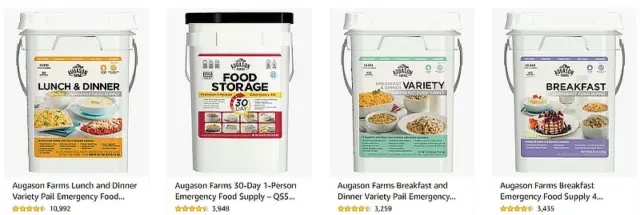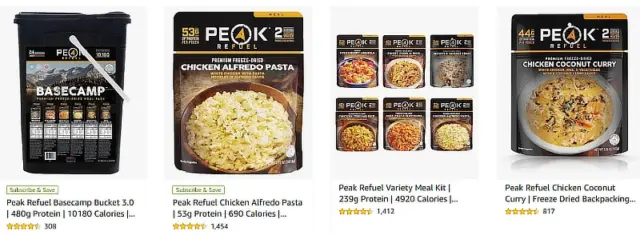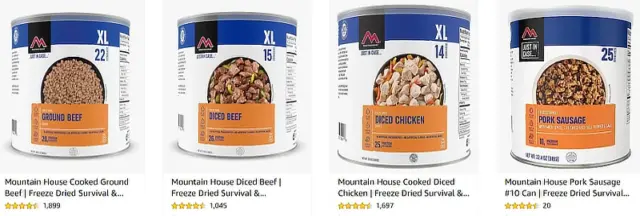Best Emergency Survival Food Companies Short List

Who are the best emergency food companies? Regarding survival food and the companies who sell it, I suggest companies that have been around for more than just a year or two or three. I will list a few of my favorites, any of which I recommend.
I could have made a much longer emergency food companies list. However, I chose those which I’ve known for years, those which I have purchased, and have stood the test of time.
The longevity of a company within the emergency food marketplace is a reflection of good products, services, and good management.
I have been a consumer in this space for approx. 15 years, and I have learned many lessons during this time! I would like to provide a few useful tips for those who may be considering purchasing from an emergency survival food company and list some of the companies that I would consider among the better or best.
Tips Before You Purchase From Survival Food Companies
You can buy these emergency foods packaged in various ways,
Packaging
- Foods packaged in #10 cans. They are basically 6″ in diameter and 7″ tall. Foods in #10 cans are typically freeze-dried or dehydrated. Shelf life may vary from 5 years to decades depending on the type of food. The manufacturer or distributor will include this information.
- Foods packaged in containers such as sealed pails or buckets. These may contain all of one type of food, or may contain a quantity of individually sealed ‘meals’. The packaging usually contains oxygen absorbers which will help with a long shelf life. Depends on the food inside.
- Survival food packets in sealed Mylar foil bags. Sometimes these are nitrogen-filled and/or packed with O2 absorbers. These are very convenient for serving sizes.
You can also buy a wide range of quantities or kits designed for various ‘survival’ periods. For example, 1-month survival food kit. 3 months. 6 months. etc…
Servings & Calories
TIP: Most survival food companies list the “number of servings” in their emergency food kits. The key here is to understand Calories when determining how long that food will really sustain you.
If they say a particular food container has 30 servings inside, and if the servings are 400 calories each, that translates to 12,000 calories. And that translates to approx. 6 “survival days” at 2,000 calories per day. So be aware of that.
Depending on your age, sex, activity level, and body type, generally speaking, we need approx. 60,000 calories per person per month. More, depending on physical activity, or perhaps somewhat less to simply stay alive. However, this depends on the aforementioned factors.
TIP: I have observed that a typical number of calories per serving for emergency food companies, is often between 300 and 400 calories.
TIP: I have made this mistake. When choosing a company and/or emergency food, you might consider buying a smaller quantity at first. Make sure that you are happy with it! Eat a meal. Does it taste okay? Or is it not what you expected.
TIP: Read the ingredients label. It’s fairly easy to stuff a lot of carbohydrates in there. But what about protein? I’ll link an article about how much protein you need at the end of this one.
Survival Food Companies List
Best Survival Food Companies
I have purchased from ALL of the following survival food companies. These are among the best, in my opinion. I’ve been happy with all of them. Keep reading for more details about each.
Okay, you wondered about companies who sell this. The thing is, there are lots of them. Rather than clutter the page with a long list, I will list just a few to keep it simple. And those which I would not hesitate to recommend.
The following survival food companies have been around for a good while, and are those which I have purchased from (and would buy again). They have good reviews among the preparedness community and are established within the industry. There are more than this list, but these stand out in my mind among the better or best ones, in my opinion.
(more details below)
Augason Farms is located in Salt Lake City, Utah. In business since 1998.
ReadyWise is located in Salt Lake City, Utah. In business since 2009.
Peak Refuel is located in American Fork, Utah. In business since 2018.
Mountain House is located in Albany, Oregon. In business since 1969.
Legacy is located in Salt Lake City, Utah. In business since 2009.
Augason Farms

Though she has since passed away, I recall email correspondence with Jacqueline Augason when I first started my blog more than a decade ago. Great company and they are greatly flourishing today – Augason Farms under the umbrella of ‘Blue Chip Group’.
I do have a good bit of Augason Farms product in #10 cans. We especially like their milk powder choices better than any other (view on amzn).
They sell LOTS of emergency survival food products including bulk grains, freeze-dried foods in #10 cans, and buckets of individually packaged meals. They have a well-reviewed variety of emergency food kits (their e-food-kits on amzn)
I highly recommend Augason Farms as one of your best choices for emergency food.
ReadyWise

ReadyWise is a VERY popular emergency food company. Their best-sellers are primarily various variety pack food buckets (examples on amzn).
They have quite a significant presence on amzn online, with an exceptional number of great reviews. I’ve had their product, and have been happy with them.
There are also gluten-free emergency food choices (example).
Note the following… To determine the number of ‘survival days’ worth of food, multiply #servings times #calories per serving. Figure 2,000 calories needed per survival day.
Peak Refuel

Peak Refuel is focused on single-pack freeze-dried meals (similar to Mountain House). They’re fairly new. Pricey, but very good (like Mountain House products). I’ve sampled quite a number of their meals and they are excellent!
I believe their freeze-dried meals contain the highest protein content among all of the survival food companies (more meat content).
I highly recommend purchasing Peak Refuel if it fits your budget. Having purchased myself, I can vouch for their high-quality ingredients.
Mountain House

Mountain House has been in the industry of freeze-dried foods the longest. Nearly everyone knows their name and reputation.
Mountain House Meals and Kits on amzn
Well known for their individual freeze-dried sealed meals (e.g. camping & backpacking), the quality is superb. And expensive (just saying).
They also sell their foods in bulk such as #10 cans of freeze-dried, and they also have some food pails/bucket kits too. You won’t go wrong here.
Legacy Premium Survival Food Kits

Legacy Food Storage Company has been around for a long time. Located in Salt Lake City, they’ve been among the best survival food companies since 2009.
Some of their highlights include a premium next-level offering in taste and quality, non-GMO, no MSG or artificial flavors, and a focus on good value versus calories.
Diversify Your Emergency Food Storage Sources
What is it that I do? Diversify! I do have quantities of food that I have purchased from survival food companies such as those listed above. This is just part of my overall emergency food storage.
I also have quantities of various dry foods that I’ve purchased in bulk and stored/packaged myself. This includes dry goods such as wheat, rice, oats, beans, sugar, salt, etc.. These will store well for decades without issue.
Also, over time, I’ve purchased a quantity of various grocery store canned foods, with a focus on proteins and calories (e.g. canned meats). Note that these should be consumed and rotated with an approximate 2-year period for best results.
I store a lot of protein and calories in my chest freezers filled with vacuum-sealed meats (beef, chicken, pork).
Bulk quantities of spices, oils (freeze oils for longevity), and complimentary foods.
In essence, a diversified portfolio of foods. Search my blog ‘survival kitchen’ category for more ideas.
Having said that, it is certainly quick and easy to purchase foods from companies such as those listed above. Pay attention to calorie counts so that you know how many ‘survival days’ you are purchasing.
Buying food ‘kits’ and emergency food from companies — does tend to cost more, but it is quicker and does have its place in anyone’s emergency food storage plan.
[ Read:
